As recently as the 1990s few multinational suppliers had managed to establish a presence in Brazil. Overseas companies were deterred by government legislation dictating that they had to install manufacturing plants in the country if they wanted to enter the market. But when these laws were relaxed in the early 1990s it opened the floodgates with a raft of overseas brands, from the likes of Unilever, Danone and Nestlé, hitting the supermarket shelves. Even some of the UK’s most quintessentially British products - like shortbread and real ale - followed on the coattails of this invasion.
The influx of foreign grocery retailers was a more recent phenomenon, but the Brazilian supermarket sector is now dominated by a handful of major multinationals - notably Walmart, Carrefour and Casino.
Most have accessed Brazil through acquisitions: Walmart via Lojas Americanas in 1994, while the country’s largest grocery retailer, Casino, entered after a protracted battle to gain a controlling stake in GPA, owner of Pão de Açúcar.
The reason for this overseas invasion is simple. In line with Brazil’s status as one of the so-called BRIC fast-growth economies, the grocery retail sector has been expanding at a rapid rate of knots, with food consumption in Brazil rising by 4% in volume and 13% in value in 2013, according to Flavia Amado from Kantar Worldpanel’s Latin America office. Euromonitor anticipates this growth will continue over the next few years, with grocery retailers expected to post a constant value CAGR of 4% between 2012-17.
Mouthwatering
The statistics are, on paper, mouth watering. A country the size of Europe, with a GDP of $2.5tr (bigger than the UK), Brazil boasts a rapidly expanding middle class - in 2003 the middle classes accounted for 38% of the population whereas today it is north of 51% [OSEC]. In 2011, the total size of the grocery retail market in Brazil exceeded $370bn [Canadean], with the food and drink export market worth £3.9bn the same year [Food & Drink Exporters Association]. From 2007 to 2011 the country experienced a 140% increase in imported goods [FDEA], with this figure projected to grow further in the next few years as more international suppliers look to secure a piece of the action.
But it’s not all been plain sailing for these international marauders. According to Daniel Wada, a partner at strategy consultants Advisia OC&C, a lack of understanding of Brazil’s complexities has at times presented a major challenge to growth. Importers face a combination of high tax rates, all products must have Portuguese labels and although the nation’s infrastructure is slowly improving there are a number of lingering logistical challenges.
“Foreign retailers need to look at Brazil as a continent, not a country because of the differences between the regions in terms of income, population and diversity,” says Wada. “Each region has to be approached separately because the homogenous approach does not work. .
Marcos Calliari, managing director for Kantar Worldpanel Brazil, goes further, describing the economic situation in Brazil over recent months as “not at all positive”. After a decade of strong growth the nation’s economy is showing signs of stalling, with ratings agency Standard & Poor’s downgrading Brazil’s credit rating in April.
“Be patient, don’t expect immediate or large amounts of business, and be prepared for long, tedious bureaucracy”
Experts are pinning their hopes of an economic recovery on the host nation’s performance in the upcoming tournament. “Success in the World Cup could lead to a revival in the Brazilian miracle,” says James Massoud, editor of BRIC Magazine. And major fmcg groups are expected to play a vital role in this miracle, he adds, “particularly given that 74% of the market there is comprised of around 20 companies, each with reported revenues of over $65m”.
There are enormous regional differences in terms of taste and cuisine, but the iconic food and drinks of Brazil are…

Cachaça: Is the national spirit made from fermented sugar cane juice. It differs from rum, which is made from sugar cane molasses. It’s most famously drunk in Brazil’s national cocktail, the Caipirinha, made with limes, sugar, ice and cachaca. The spirit is also used in caipiroska instead of vodka and a caipirissima instead of rum. There are a huge number of producers with brands such as Velho Barreiro, Sagatiba and 51 being the most popular. It is the third most consumed spirit in the world, but only a tiny amount (1%) is exported.
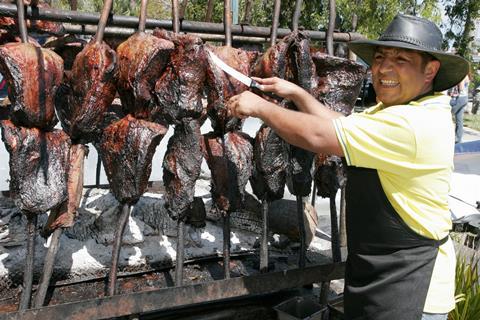
Churrasco: Churrasco is the Brazilian term for barbeque. Cooked in a churrascaria - a barbeque house - the meat is served ‘rodizio’ style (on long skewers). The tender, charred strips of meat are usually made up of a combination of beef cuts, including picanha, along with a generous selection of pork, lamb, poultry and sausages. The ‘passadores’ (waiters) move from table to table-bringing different types of meats on skewers to the customer and carve the meat directly onto the plate. It is usually accompanied by a buffet.
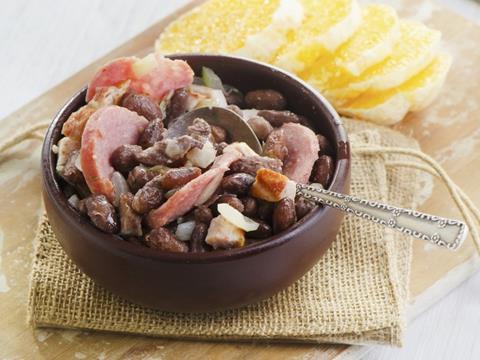
Feijoada: This mouth-watering combination of delicious savoury ingredients is perhaps the most traditional and popular Brazilian dish of them all. It originated in the north east of the country, but is eaten throughout Brazil. Although there are lots of variations on the recipe it always includes beans, smoked sausage, salt pork, salted pork ribs, smoked pork breast, beef and dried meat. The dish is a regular lunch party dish and can take up to 24 hours to prepare. It is often served with kale or greens and rice or farofa.
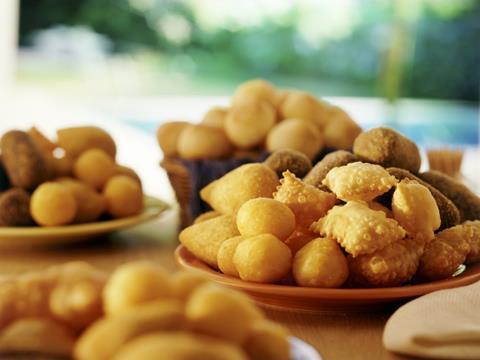
Salgadinhos: This is a generic terms for hand-held snacks. While always flour-based many varieties of flour are used, including corn, cassava and potato, and the resulting pastry is unlike what we are used to in the UK. Traditionally served as party or street food, the snacks are either deep fried or oven baked. The most popular are coxinha made from chicken; pastel, which are a hearty affair made with chicken, meat, ham or cheese; risolio made from chicken or corn; empadinha and esfirra made of tomato, meat and spices.

Pao de Queijo: This cheese bread is the most popular snack across Brazil. A quick cafezinho with pao de queijo (which translates as coffee with cheese bread) is part of everyday life for Brazilians, especially in Minas Gerais, where the snack first originated. Made with cassava flour (tapioca flour), the ground root of the manioc plant and the Brazilian cheese queijo minas (similar to an English Wensleydale), the cheese bread can be easily made at home from scratch or a packet mix and is often cooked from frozen.
UK importers
One of the most prominent British brands currently negotiating its way through the minefield of doing business in Brazil is ABF-owned Twinings. David Care, business development manager for Latin America, says Twinings is now the fourth largest tea brand in São Paulo state, an area with an estimated population in excess of 40 million. Despite Twinings’ recent success Care admits that more needs to be done if it is to realise its goal of being tea market leader by 2020.
“In Brazil, 94% of tea sales come from infusions, not the strong, black tea that is the norm back in the UK, hence we will be focusing the majority of our efforts in this area.”
As well as enjoying a nice cuppa, Brazilians also love a drink, much to the delight of UK alcoholic beverage producers - the FDEA sees sales of alcoholic drinks and soft drinks as being two of the biggest opportunities for UK brands.
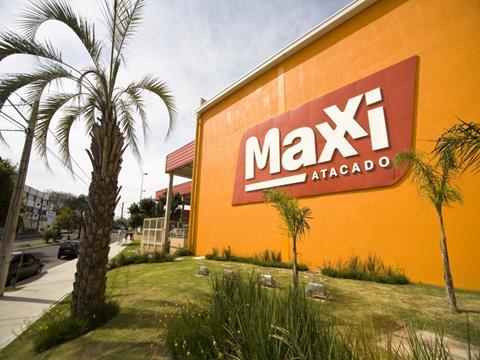
Brazil is the leading worldwide export market for Johnnie Walker Red Label whisky brand, one of an extensive portfolio of international products Diageo has been successfully pitching to Brazilian consumers for the past 15 years. However, the spirits market is dominated by local beverage cachaça, with sales of other spirits relatively low in global terms. According to a Diageo spokesperson, whisky only has 17% penetration and vodka 24% - in more mature markets, these numbers are above 30%.
Not so beer, of course, with Skol, Brahma and Bohemia among Brazil’s most valuable brands [Millward Brown]. There is also growing demand for premium real ales in Brazil. Diageo has been distributing Guinness in the country since 2000. Other brands making inroads in the premium beer category include Fuller’s London Pride and India Pale Ale, and Greene King’s Old Speckled Hen, which has been “extremely well received” in Brazil since its introduction in 2001, according to export sales director, Richard Cutler.
“We experience strong year-round demand for both kegs to drink at the bar and cans for at-home consumption,” he explains. Greene King also launched its Belhaven range last year and Cutler says the lines have received a good reception, especially in speciality beer stores.
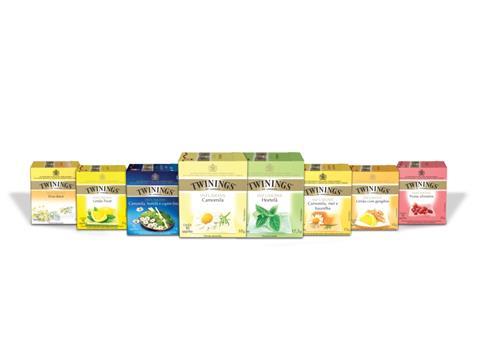
What UK brands are exporting
Aspall: vinegar and cider
BrewDog: entire core range
Diageo: Johnnie Walker, Guinness, plus range of non-UK brands
Fuller’s: London Pride, Organic Honey Dew, ESB, India Pale Ale, London Porter, Golden Pride, 1845, Black Cab Stout and Wild River
Greene King: Old Speckled Hen, Old Crafty Hen, Hen’s Tooth, Old Golden Hen, Belhaven Twisted Thistle, Belhaven Wee Heavy, Belhaven Scottish Stout, Greene King Strong Suffolk, Greene King Abbot Reserve and Wexford Cream Ale
Twinings: range of 22 teas
Walkers: shortbread biscuits
BrewDog
The most recent entrant to the Brazilian beer market was controversial Scottish craft brewer BrewDog, which launched its own bar in São Paulo, in January this year. International manager Neil Taylor says the brand has enjoyed a “phenomenal” response to the bar and the BrewDog range of beers sold through it. So much so it is poised to launch a beer specially for Brazilian punters called ‘Hello, My name is Zé’, in the coming months.
One of the main challenges premium players like BrewDog face is determining an acceptable price for their products. “Brazil imposes high taxes on imported products so trying to reach an attractive price point - especially versus domestic beer - can be a challenge,” explains Cutler.
His advice to companies looking to export to Brazil, is to find the right import partner. “It is important to have confidence in the people who look after your sales day in, day out, when you can only visit the market once or twice a year,” says Cutler.
It’s a view echoed by a spokesman for Fuller’s: “Be patient, don’t expect immediate or indeed large amounts of business and be prepared for often long, tedious bureaucracy and form filling. There are opportunities, but they are limited at present.”
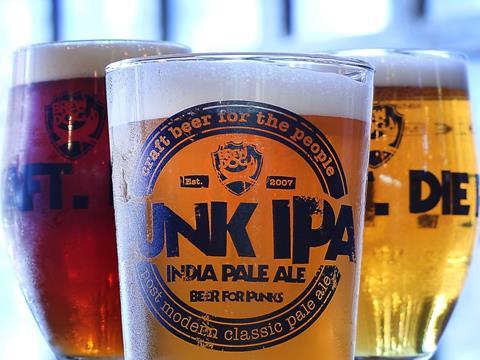
Image problem
Henry Chevallier Guild, an eighth generation cider maker at Aspall, which markets its cider and vinegar brands in Brazil, has another issue to overcome: the downmarket image cider has in Brazil. As a result, Aspall has struggled to achieve the price positioning a premium brand requires, he says. “Brazilians tend to shun cider purely from an image perspective and, until that perception is broken, cider will be a bit-part drinks player, regardless of where it is made,” he says.
Whatever product food and drink companies are peddling, OC&C’s Wada believes the World Cup will aid sales. He says the tournament is being seen by all Brazilian retailers - not just the big supermarkets - as a huge marketing opportunity, with beverage companies expected to be one of the main beneficiaries. Wada also predicts this growth trend will be sustained through to the Rio Olympics in 2016.
But not everyone is getting swept along in the excitement. “After a decade of growth and wealth distribution, the country is facing a slowdown and economic analysts have given a pessimistic outlook for the future,” says Calliari. “The World Cup has not been able to reverse that, as public opinion has significantly turned against the event, and FIFA, due to the perception of corruption and little positive legacy.”
Hopefully, if Brazil wins the upcoming tournament, that may all change. Following the nation’s triumph in the 1970 World Cup Brazil enjoyed a 12-year economic boom. GDP also grew significantly in the wake of Brazil winning the 1994 World Cup in the USA and the 2002 tournament in Japan. As a result, grocery suppliers and retailers alike will no doubt be praying the nation triumphs once more in 2014.



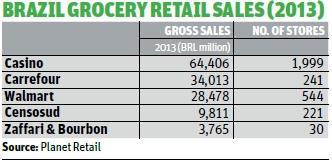

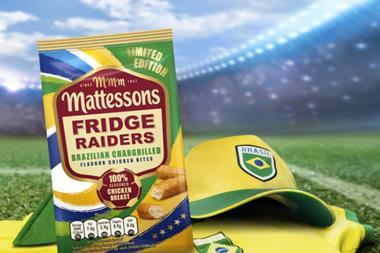

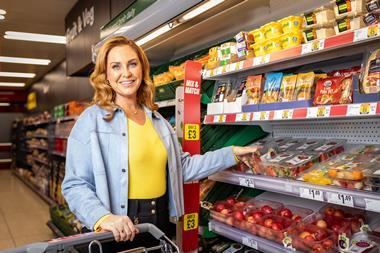
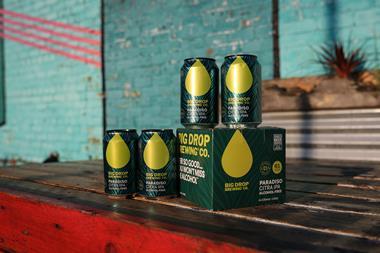

No comments yet